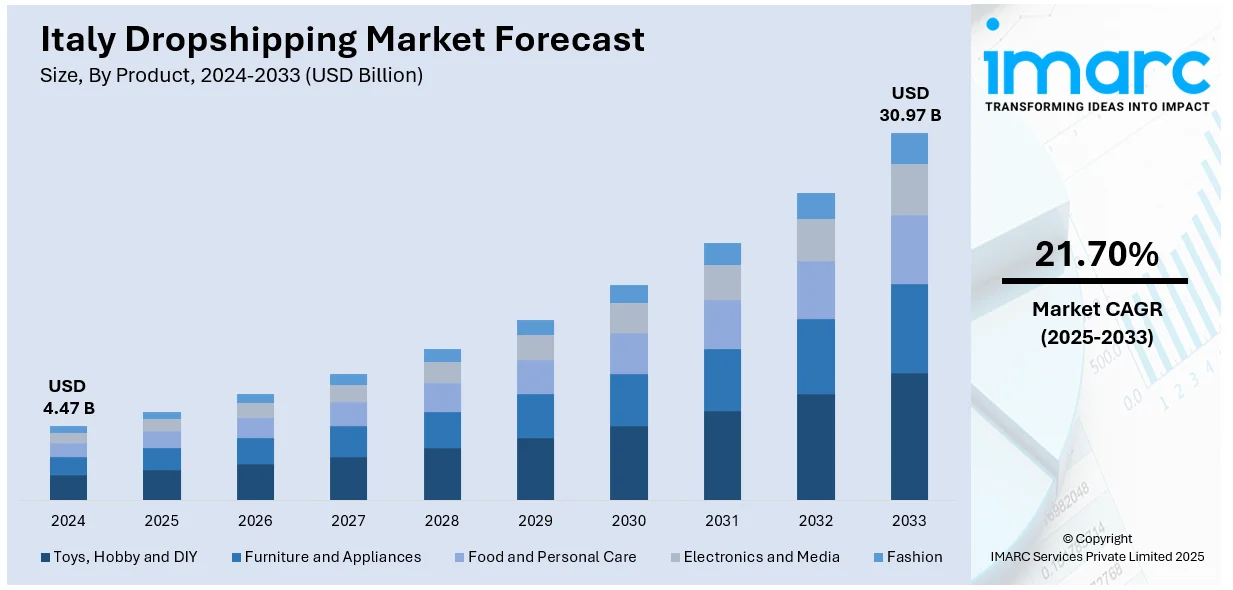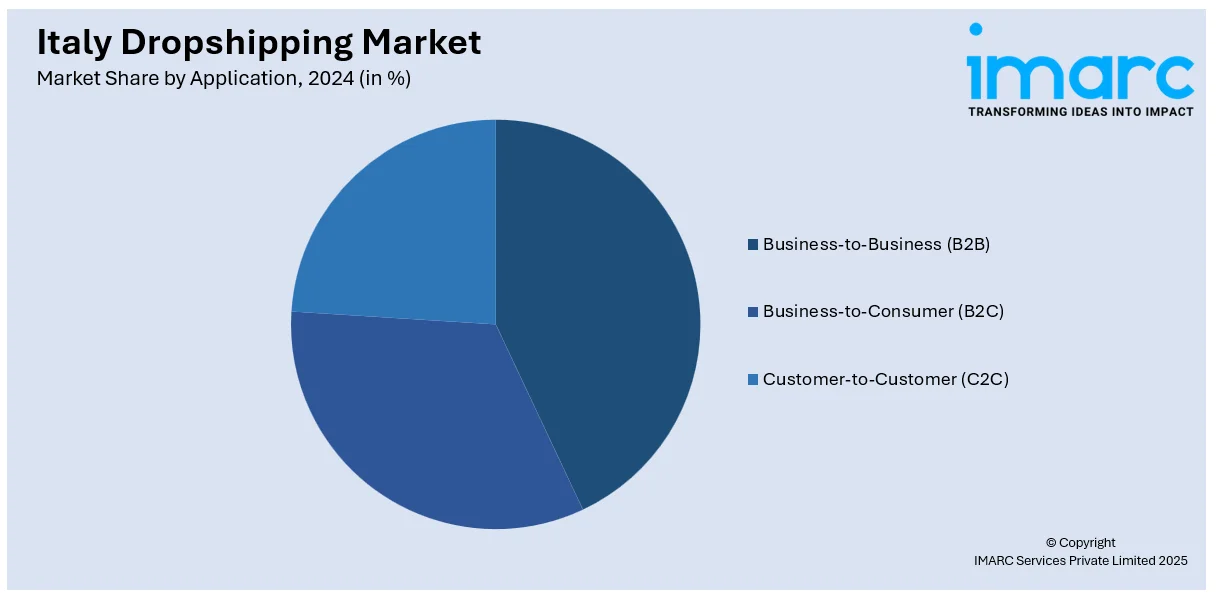
Italy Dropshipping Market Size, Share, Trends and Forecast by Product, Type, Application, and Region, 2025-2033
Italy Dropshipping Market Size and Share:
The Italy dropshipping market size reached USD 4.47 Billion in 2024. Looking forward, IMARC Group expects the market to reach USD 30.97 Billion by 2033, exhibiting a growth rate (CAGR) of 21.70% during 2025-2033. The market is growing because of rapid digitalization, increasing e-commerce adoption, secure payment systems, AI-driven marketing, cloud-based inventory management, sustainability initiatives, cost-effective logistics, optimized supply chains, and regulatory support for eco-friendly and technology-driven dropshipping operations in Italy.
|
Report Attribute
|
Key Statistics
|
|---|---|
|
Base Year
|
2024
|
|
Forecast Years
|
2025-2033
|
|
Historical Years
|
2019-2024
|
| Market Size in 2024 | USD 4.47 Billion |
| Market Forecast in 2033 | USD 30.97 Billion |
| Market Growth Rate (2025-2033) | 21.70% |
Italy Dropshipping Market Trends:
E-commerce Growth and Digital Transformation
Italy’s dropshipping market is expanding due to rapid digitalization and increasing online shopping adoption. The size of the e-commerce market in Italy reached US$ 85.88 billion in 2024, according to the IMARC Group, reflecting strong consumer demand and a growing preference for online retail. E-commerce penetration is rising as users shift from traditional retail to digital platforms for greater convenience, wider product variety, and competitive pricing. The increasing adoption of secure payment gateways, mobile commerce, and social media integration is enhancing user experience and accelerating digital transactions. Government initiatives supporting digital entrepreneurship and encouraging small and medium enterprises (SMEs) to establish online sales channels are further fueling market growth. Expanding internet connectivity and smartphone usage are enabling broader access to online shopping, while AI-driven marketing strategies are improving customer targeting and engagement. Advancements in logistics, including faster last-mile delivery and warehouse automation, are strengthening the efficiency of dropshipping operations. The integration of cloud-based inventory management and AI-powered order processing is helping businesses streamline operations without requiring large capital investments. Additionally, cross-border e-commerce is expanding opportunities for Italian retailers, allowing them to source products globally while reaching international consumers. As digital transformation accelerates, Italy’s dropshipping market is market for sustained growth.

Sustainability and Cost-Effective Logistics in Dropshipping
Sustainability and operational efficiency are playing a crucial role in the growth of Italy’s dropshipping market as businesses prioritize eco-friendly solutions to reduce costs and environmental impact. Retailers and logistics providers are adopting reusable packaging, optimized supply chains, and waste reduction strategies to meet rising consumer demand for sustainable e-commerce. Cost-effective logistics solutions, including resource-efficient warehousing and transport systems, are improving profitability while aligning with corporate sustainability goals. A recent example of this trend is the partnership between Tosca and Megamark, announced in 2025. Megamark, a leading Italian retailer, is integrating Tosca’s reusable packaging solutions to enhance operational efficiency while reducing environmental waste. This collaboration aims to improve logistics and support Megamark’s sustainability initiatives. The adoption of circular economy practices is strengthening long-term supply chain resilience, reducing dependence on single-use materials, and minimizing carbon footprints. As regulatory frameworks encourage greener business models, dropshipping companies that integrate sustainability into their logistics strategies gain a competitive advantage. Investments in energy-efficient fulfillment centers and sustainable last-mile delivery solutions are further driving market expansion. With increasing awareness of environmental responsibility, dropshipping businesses implementing sustainable logistics practices are enhancing brand perception, fostering consumer trust, and ensuring long-term market stability in Italy’s growing e-commerce sector.
Italy Dropshipping Market Segmentation:
IMARC Group provides an analysis of the key trends in each segment of the market, along with forecasts at the region level for 2025-2033. Our report has categorized the market based on product, type, and application.
Product Insights:
- Toys, Hobby and DIY
- Furniture and Appliances
- Food and Personal Care
- Electronics and Media
- Fashion
The report has provided a detailed breakup and analysis of the market based on the product. This includes toys, hobby and DIY, furniture and appliances, food and personal care, electronics and media, and fashion.
Type Insights:
- Same-Day Delivery
- Regional Parcel Carriers
- Heavy Goods Deliver
A detailed breakup and analysis of the market based on the type have also been provided in the report. This includes same-day delivery, regional parcel carriers, and heavy goods deliver.
Application Insights:

- Business-to-Business (B2B)
- Business-to-Consumer (B2C)
- Customer-to-Customer (C2C)
The report has provided a detailed breakup and analysis of the market based on the application. This includes business-to-business (B2B), business-to-consumer (B2C), and customer-to-customer (C2C).
Regional Insights:
- Northwest
- Northeast
- Central
- South
- Others
The report has also provided a comprehensive analysis of all the major regional markets, which include Northwest, Northeast, Central, South, and others.
Competitive Landscape:
The market research report has also provided a comprehensive analysis of the competitive landscape. Competitive analysis such as market structure, key player positioning, top winning strategies, competitive dashboard, and company evaluation quadrant has been covered in the report. Also, detailed profiles of all major companies have been provided.
Italy Dropshipping Market Report Coverage:
| Report Features | Details |
|---|---|
| Base Year of the Analysis | 2024 |
| Historical Period | 2019-2024 |
| Forecast Period | 2025-2033 |
| Units | Billion USD |
| Scope of the Report |
Exploration of Historical Trends and Market Outlook, Industry Catalysts and Challenges, Segment-Wise Historical and Future Market Assessment:
|
| Products Covered | Toys, Hobby and DIY, Furniture and Appliances, Food and Personal Care, Electronics and Media, Fashion |
| Types Covered | Same-Day Delivery, Regional Parcel Carriers, Heavy Goods Deliver |
| Applications Covered | Business-to-Business (B2B), Business-to-Consumer (B2C), Customer-to-Customer (C2C) |
| Regions Covered | Northwest, Northeast, Central, South, Others |
| Customization Scope | 10% Free Customization |
| Post-Sale Analyst Support | 10-12 Weeks |
| Delivery Format | PDF and Excel through Email (We can also provide the editable version of the report in PPT/Word format on special request) |
Key Questions Answered in This Report:
- How has the Italy dropshipping market performed so far and how will it perform in the coming years?
- What is the breakup of the Italy dropshipping market on the basis of product?
- What is the breakup of the Italy dropshipping market on the basis of type?
- What is the breakup of the Italy dropshipping market on the basis of application?
- What is the breakup of the Italy dropshipping market on the basis of region?
- What are the various stages in the value chain of the Italy dropshipping market?
- What are the key driving factors and challenges in the Italy dropshipping market?
- What is the structure of the Italy dropshipping market and who are the key players?
- What is the degree of competition in the Italy dropshipping market?
Key Benefits for Stakeholders:
- IMARC’s industry report offers a comprehensive quantitative analysis of various market segments, historical and current market trends, market forecasts, and dynamics of the Italy dropshipping market from 2019-2033.
- The research report provides the latest information on the market drivers, challenges, and opportunities in the Italy dropshipping market.
- Porter's five forces analysis assist stakeholders in assessing the impact of new entrants, competitive rivalry, supplier power, buyer power, and the threat of substitution. It helps stakeholders to analyze the level of competition within the Italy dropshipping industry and its attractiveness.
- Competitive landscape allows stakeholders to understand their competitive environment and provides an insight into the current positions of key players in the market.
Need more help?
- Speak to our experienced analysts for insights on the current market scenarios.
- Include additional segments and countries to customize the report as per your requirement.
- Gain an unparalleled competitive advantage in your domain by understanding how to utilize the report and positively impacting your operations and revenue.
- For further assistance, please connect with our analysts.
 Request Customization
Request Customization
 Speak to an Analyst
Speak to an Analyst
 Request Brochure
Request Brochure
 Inquire Before Buying
Inquire Before Buying




.webp)




.webp)












